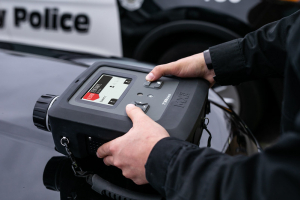Transforming Customs Enforcement: How Modern Spectroscopy Techniques Enable Revenue Protection
28 October 2025
By John Johnson, Vice President of North America and Strategic Marketing, 908 DevicesA new era in customs enforcement
It is estimated that the chemical industry, through both direct and indirect impacts, represents 7% of the global GDP and an estimated 120 million jobs[1]. The sector is growing due to an accelerated demand for battery chemicals built itself on a stable demand from the automotive, energy, and electronics industries[2].
Although comprehensive global import/export tonnage data is harder to pinpoint, production numbers alone suggest that several billion tons of chemicals are traded across borders each year, encompassing everything from industrial solvents to pharmaceutical intermediates and specialty chemicals. According to the United States Environmental Protection Agency, the U.S. reports importing and exporting over 7 trillion pounds each year[3].
Minor errors in classification, misrepresentations in product grade, and diversion of chemicals for the production of drug and illicit commodities is not uncommon. Researchers who analyzed trade data for 46 highly hazardous chemicals subject to the Rotterdam Convention found out of a total of 64.5 million tonnes traded globally from 2004 to 2019, 27.5 million tonnes were traded illegally, i.e., exported to countries that had explicitly refused to import them[4]. In recent years, individual enforcement cases have uncovered multi-million-dollar instances of tariff evasion, and persistent discrepancies between declared and actual shipments remain a recurring problem in global trade data. Increase in tariffs in some countries is expected to correlate to an increasing incentive to find solutions to reduce costs that are at best creative, but often fraudulent.
As trade volumes continue to rise, Customs authorities need not just faster methods of inspection but more technologically advanced tools capable of providing accurate, defensible chemical identification at the point of entry.
Recent innovations in portable analytical instrumentation are answering that call. A new generation of handheld systems now combine Fourier-transform infrared spectroscopy (FTIR) and Raman spectroscopy into a single platform. These dual-technology systems represent a major leap forward in Customs enforcement, allowing officers to identify chemicals from a single sample, without preparation, and to do so with a level of confidence that was previously only possible in laboratory environments.
Fusing spectroscopy systems: the power of two
FTIR and Raman spectroscopy are both well-established analytical techniques. Each offers unique advantages: FTIR excels at identifying functional groups and detecting polar molecules, while Raman provides complementary information based on molecular vibrations and is particularly effective in analyzing non-polar compounds. By fusing these technologies into a single system, officers in the field can capture a more complete molecular fingerprint of unknown substances.
The innovation lies not just in the integration of the hardware, but in the development of algorithms that synthesize and interpret spectral data from both techniques simultaneously. This computational advancement, often powered by proprietary signal processing engines, enhances accuracy, resolves complex mixture identification, and significantly reduces the ambiguity that can arise from relying on a single method. In effect, this dual-confirmation capability enables inspectors to rapidly validate chemical identity, resolve classification disputes, and detect fraud, all with high scientific confidence. One of the emerging and more innovative techniques currently being deployed is called Smart Spectral Processing or SSP.

Chemical libraries enable real-time classification and revenue recovery
One of the most immediate and impactful applications of dual-mode spectroscopy for Customs applications is in tariff code validation. Customs officers are responsible for ensuring that the Harmonized System (HS) codes declared on shipping paperwork accurately reflect the chemical substances being imported. For many compounds, particularly those with subtle structural differences or varying levels of purity, this is a non-trivial task. Slight misclassifications, whether accidental or deliberate, may lead to significant underpayment of duties, VAT, or the circumvention of anti-dumping tariffs.
Real-time identification through the integration of FTIR and Raman spectroscopy now allows Customs personnel to analyze chemical composition on-site, using a single sample and without lab-based delays. This fusion of techniques delivers a robust molecular fingerprint, enabling officers to verify whether the substance in question matches its declared documentation. Whether distinguishing between technical- and pharmaceutical-grade solvents, confirming the presence of regulated precursors, or assessing the composition of specialized industrial compounds, the ability to verify identity at the point of inspection translates directly into fiscal integrity and the recovery of lost revenue.
Critically, the performance of these systems is deeply influenced by the breadth and quality of their onboard spectral libraries. A larger library means more reference spectra for comparison, which in turn increases the likelihood that an unknown sample will match a known compound. This not only accelerates the inspection process but reduces uncertainty in enforcement decisions. When a system can identify a substance quickly and confidently, clearance decisions are made faster and compliant shipments move without unnecessary delay.
Still, there are situations where a confident result is not achieved. In such cases, Customs officers have two practical mitigation strategies at their disposal. The first is to manually search the onboard spectral library for the compound listed on the shipping paperwork. If that compound exists in the system’s database, but the instrument fails to identify it in the sample, this discrepancy may suggest a mislabel or deliberate attempt to subvert Customs classification rules, warranting further investigation. The second option is to escalate the spectral data to a manufacturer’s reachback service or a national forensic laboratory. These expert resources can interpret both FTIR and Raman spectra and may be able to identify unknowns using advanced software or external databases not accessible in the field. Lastly, once the chemical has been positively identified, either by reachback, laboratory support, or confirmed inspection, it can be added to the device’s onboard library. This process improves future performance by expanding the system’s recognition capabilities, allowing it to link the compound to its appropriate HS code and further strengthen the Customs agency’s inspection infrastructure over time.
In this way, spectral libraries do more than support individual identifications – they form the backbone of a continuously improving, real-time Customs enforcement capability that scales in value with every new identification made.
Addressing VAT evasion and anti-dumping fraud
Beyond classification, Raman and FTIR spectroscopy also play critical roles in detecting evasive practices such as VAT fraud and anti-dumping circumvention. In many jurisdictions, tax rates vary depending on the grade, purity, or the formulation of a chemical. Traders seeking to reduce tax liability may attempt to declare higher-value products as lower-grade equivalents, dilute compounds to avoid regulation, or misrepresent controlled substances as benign.
With the dual-technology approach, Customs personnel can analyze these materials on-site and determine if the substance matches its documentation. These systems can detect subtle differences that might be missed by a single spectroscopic method, revealing the true nature of the shipment. This is particularly valuable in identifying edge cases: diluted formulations, complex mixtures, or substances masked with additives to obscure their identity. The result is better enforcement of trade protections, more equitable market conditions, and a more resilient Customs revenue pipeline.
Advancing clearance efficiency without compromising control
One of the longstanding tradeoffs in Customs enforcement has been the balance between control and efficiency. The need to send samples for laboratory analysis can delay clearance, burden traders, and slow the pace of legitimate commerce. By leveraging modern spectroscopy techniques, these bottlenecks are largely removed with both speed and confidence. Officers can now conduct high-confidence chemical analysis in under a minute, from a single sample. This accelerates the clearance of compliant shipments, reduces inspection backlogs, and allows Customs agencies to capture taxes and duties more quickly. For countries where border duties represent a major component of national revenue, the ability to shorten the enforcement cycle without sacrificing accuracy is transformative.
Informing risk-based screening with high-fidelity, connected data
In today’s intelligence-led Customs environment, the effectiveness of risk-based targeting models hinges on the quality and consistency of data gathered at the field level. Raman and FTIR spectroscopy systems, particularly those integrated into connected, field-deployable platforms, now play a central role in this process. Each inspection produces high-fidelity chemical identification data, which can be automatically transmitted over secure communications networks to central fleet management and maintenance systems.
This connected architecture transforms each individual unit, from a busy seaport to a remote border crossing, into a node in a unified data ecosystem. Chemical identification results, including hits, inconclusive scans, or patterns of non-identification, can be aggregated in real time across an unlimited number of deployed systems. This allows Customs agencies to detect broader trends that may not be visible at the individual inspection level. For instance, a recurring absence of expected matches for certain declared substances across multiple locations may indicate a new concealment tactic, deliberate mislabeling, or a coordinated evasion scheme.
Centralized analytics platforms can ingest this data to refine targeting algorithms, support advanced pattern recognition, and generate alerts for anomalies or emerging risks. Field outcomes then feed directly back into the national intelligence framework, enabling dynamic adjustments to screening protocols, updating library entries, and optimizing resource deployment. By linking portable spectroscopy tools with real-time data infrastructure, Customs agencies not only improve the accuracy of frontline inspections they also build a responsive, adaptive enforcement network that continuously evolves with the tactics of the global trade environment.
From innovation to impact
What makes this technological shift so impactful is its ability to integrate laboratory-grade certainty into frontline operations, enabling Customs agencies to act decisively in the moment. The combination of FTIR and Raman spectroscopy in a single handheld device, paired with real-time data integration algorithms, represents a new class of enforcement tool: one that is fast, reliable, and directly aligned with the fiscal priorities of modern border management. As Customs agencies face mounting trade volumes, evolving smuggling tactics, and tighter budget constraints, this kind of innovation is not merely desirable – it is essential. Advanced, field-based FTIR and Raman spectroscopy combined systems now offer the ability to enforce classification rules, recover lost revenue, accelerate clearance of compliant goods, and contribute to data-driven targeting strategies – all from the field, in real time.
More information
mail the author
908 Devices website
[1] https://www.chemicalindustryjournal.co.uk/5-7-trillion-contribution?utm
[2] https://www.marketsandmarkets.com/Market-Reports/global-chemical-industry-outlook-89294716.html?utm
[3] https://www.epa.gov/chemical-data-reporting/chemical-production-data?utm
[4] https://www.sciencedaily.com/releases/2023/07/230711133230.htm
As Vice President of North America and Strategic Marketing, John Johnson oversees the strategic direction and market adoption of the 908 Devices handheld systems including mass spectrometry, Raman spectroscopy and FTIR spectroscopy. John has served in many roles over the course of his 30 years in public safety, launching 17 different products in over 61 countries and working with more than 500 enterprise public safety organizations. Since 2001, John has focused his efforts on changing mindsets and driving the acceptance of novel technological approaches for identifying explosives, chemical weapons and narcotics by bringing technology used in forensic laboratories into the field, including mass spectrometry, FTIR, Raman, and Rapid DNA. John’s influence in these areas has led to standard industry practices and broad technology adoption, all aimed at improving public safety outcomes.

